Daylily Hemerocallis 'Tuxedo Junction'

ABOUT
The Hemerocallis 'Tuxedo Junction', commonly known as the Daylily, boasts a striking visual appeal with its unique floral characteristics. The widely celebrated feature of this Daylily is its flowers, which exude a sense of drama and elegance. The blooms typically showcase a rich, deep purple hue that can sometimes appear almost black, contrasting dramatically with a vibrant yellow-green throat at the center. This contrast creates a 'tuxedo-like' appearance, hence the name 'Tuxedo Junction'. The flowers are trumpet-shaped, a signature look of Daylilies, and they perch gracefully atop tall, sturdy stalks that emerge from a lush clump of arching, green, blade-like foliage. The leaves themselves present a bright, healthy green color that serves as a perfect backdrop for the vivid blooms. The flower's petals may exhibit a subtle ruffled edge, contributing to the plant's overall ornamental appeal. Due to its perennial nature, the Hemerocallis 'Tuxedo Junction' makes a recurrent statement in the garden with its reliable yearly performance. While individual flowers typically last only one day, the plant produces numerous buds that open successively over a long blooming period, ensuring a continual display of its magnificent flowers throughout the season. Its appearance makes it a popular choice for gardeners looking to add a touch of sophistication and depth to their garden palette.
About this plant
 Names
NamesFamily
Hemerocallidaceae
Synonyms
Daylily
Common names
Hemerocallis 'Tuxedo Junction'.
 Toxicity
ToxicityTo humans
Daylilies are not considered toxic to humans. In fact, many parts of the daylily plant are edible. However, it is crucial to distinguish daylilies from true lilies, which can be highly toxic. To avoid potential risks, always accurately identify a plant before ingesting it and be aware of individual allergies or sensitivities that could lead to adverse reactions.
To pets
Daylilies are highly toxic, especially to cats. If a pet ingests any part of a daylily, it can lead to severe kidney damage. Symptoms of poisoning in pets may include vomiting, lethargy, appetite loss, and potential kidney failure. Immediate veterinary attention is necessary if a pet has consumed any part of a daylily.
 Characteristics
CharacteristicsLife cycle
Perennials
Foliage type
Deciduous
Color of leaves
Green
Flower color
Mixed
Height
2 feet (0.61 meters)
Spread
2 feet (0.61 meters)
Plant type
Herb
Hardiness zones
3-9
Native area
Asia
Benefits
 General Benefits
General Benefits- Easy to grow: Hemerocallis 'Tuxedo Junction' is known for being a low-maintenance plant that can thrive in a variety of conditions.
- Drought tolerance: Once established, Daylilies can withstand periods of low water availability, making them suitable for xeriscaping.
- Attracts pollinators: The vibrant blooms of Daylilies attract bees, butterflies, and other beneficial insects to the garden.
- Long blooming period: Hemerocallis 'Tuxedo Junction' has a lengthy flowering period, providing extended color and interest in the landscape.
- Rabbit resistance: Daylilies are generally not preferred by rabbits, making them a good choice for areas with wildlife pressures.
- Soil adaptability: They can tolerate a wide range of soil conditions, from clay to sand, as long as there is adequate drainage.
- Versatility in landscaping: Daylilies can be used for mass plantings, borders, container gardening, and as ground cover.
- Propagates easily: They can be easily divided to produce new plants, making them cost-effective and simple to spread throughout your garden.
- Color variety: Hemerocallis 'Tuxedo Junction' provides unique color contrast with its dark flowers and can complement a variety of color schemes in garden designs.
- Seasonal interest: Daylilies have attractive foliage that adds texture and greenery to gardens even when the plants are not in bloom.
 Medical Properties
Medical PropertiesThis plant is not used for medical purposes.
 Air-purifying Qualities
Air-purifying QualitiesThis plant is not specifically known for air purifying qualities.
 Other Uses
Other Uses- Daylilies like 'Tuxedo Junction' can be used as a natural clothing dye, imparting colors due to their pigments when used in traditional dyeing methods.
- These plants are effective in stabilizing slopes and controlling erosion due to their dense root system that holds soil in place.
- Daylilies can be planted in outdoor pet areas as they are non-toxic to dogs and cats, providing a safe environment for pets to play.
- The flowers of Hemerocallis 'Tuxedo Junction' can be used as a colorful and edible garnish for salads and desserts, adding a mild sweet flavor.
- Gardeners sometimes use daylilies in companion planting to add diversity and attract beneficial insects to the garden ecosystem.
- The spent blooms of daylilies can be added to compost piles, where they contribute to the creation of rich, organic compost.
- Daylily petals can be used in crafts, such as pressed flower art, due to their diverse colors and durability when dried.
- Farmers may plant Hemerocallis 'Tuxedo Junction' along fields and pastures as a decorative and low-maintenance border that requires minimal care.
- The sturdy foliage of daylilies can provide a cover for ground-dwelling wildlife, offering shelter and a habitat for small animals and insects.
- Daylilies can be used in a water garden setting where their roots can help filter and clean the water, improving the quality of the aquatic environment.
Interesting Facts
 Feng Shui
Feng ShuiThe Daylily is not used in Feng Shui practice.
 Zodiac Sign Compitability
Zodiac Sign CompitabilityThe Daylily is not used in astrology practice.
 Plant Symbolism
Plant Symbolism- Longevity: Hemerocallis, widely known as the 'Daylily', typically symbolizes longevity due to the plant's ability to thrive and bloom year after year, even under adverse conditions.
- Survival: The Daylily's resilient nature, with its ability to survive with minimal care in a wide range of environments, represents the human characteristic of enduring through challenging times.
- Adaptability: Because Daylilies are adaptable and can grow in various climates and soil types, they have become an emblem of adaptability and the ability to prosper in different life situations.
- Beauty: The graceful and vibrant blooms of the Daylily signify the beauty of life and the joy and happiness that comes with embracing every moment.
- Motherhood: In some cultures, due to its daily blooming cycle, the Daylily is a symbol of motherhood and the nurturing care mothers give each day to their children.
- Rebirth and Renewal: Since each Daylily flower lasts for only a single day, they can also symbolize rebirth and the idea that each day is a new beginning.
 Water
WaterDaylilies, such as the Tuxedo Junction, require consistent moisture, especially during their peak blooming season in summer. It is best to water them deeply once a week, providing about one inch of water which equals approximately 0.623 gallons per square yard. During periods of extreme heat or drought, the frequency may need to increase to twice a week. The water should be applied directly to the base of the plant to ensure that it reaches the roots and does not sit on the foliage, which can lead to disease.
 Light
LightDaylilies thrive in full sun, making a spot that receives at least 6 to 8 hours of direct sunlight per day ideal for the Tuxedo Junction. However, they can also perform well in partial shade, especially in hot climates, as some afternoon shade will help protect the flowers from fading too quickly. The key is achieving a balance of light that encourages vibrant blooms without causing them to wilt.
 Temperature
TemperatureThe Tuxedo Junction daylily is a resilient plant that can tolerate a wide range of temperatures. Daylilies can survive in temperatures as low as 20°F, although they prefer the climate to be between 60°F and 80°F for optimal growth and flowering. They can endure summer heat well above 90°F, but it's important to ensure they receive adequate water during these periods to prevent stress on the plant.
 Pruning
PruningPrune Tuxedo Junction daylilies to remove spent flower stalks and maintain a tidy appearance. Deadheading, or cutting back the spent blooms, encourages more flowers to form. The best time for extensive pruning is in early spring or after the plant has finished flowering for the season; this is when you should remove old foliage and any dead or damaged parts of the plant. Pruning is typically needed once or twice a year, but you can deadhead regularly throughout the blooming period.
 Cleaning
CleaningAs needed
 Soil
SoilThe Daylily 'Tuxedo Junction' thrives best in a well-drained, fertile soil mix with a pH of 6.0 to 6.5. An ideal soil mix can be created by combining equal parts of loamy garden soil, peat moss or compost, and coarse sand or perlite to aid with drainage.
 Repotting
RepottingDaylilies, including 'Tuxedo Junction', do not require frequent repotting and can often thrive in the same location for several years. They should be repotted or divided every three to five years to maintain vigor and prevent overcrowding.
 Humidity & Misting
Humidity & Misting'Tuxedo Junction' Daylilies are tolerant of a wide range of humidity levels and do well in the average outdoor environment, without requiring specific humidity adjustments.
 Suitable locations
Suitable locationsIndoor
Place Daylily 'Tuxedo Junction' in bright, indirect light indoors.
Outdoor
Plant Daylily 'Tuxedo Junction' in full sun to partial shade.
Hardiness zone
3-9 USDA
 Life cycle
Life cycleDaylilies, such as 'Tuxedo Junction', begin their life cycle as seeds or as divisions from the parent plant. After planting, the seeds germinate or the divisions establish roots, and sprouts emerge from the soil, typically in the spring. As the plant grows, it develops long, strap-like leaves and a robust root system, eventually forming a clump. Flower stalks, known as scapes, rise above the foliage in late spring or early summer, each one bearing multiple flower buds. The distinctive blooms of 'Tuxedo Junction' open daily over several weeks, often with each flower lasting just a single day, hence the common name daylily. Once the blooming period ends, the plant continues to photosynthesize and store energy, preparing for dormancy in winter, after which it will repeat the cycle the following year.
 Propogation
PropogationPropogation time
Spring-Early Summer
Hemerocallis 'Tuxedo Junction', commonly known as Daylily, is best propagated through division. This is typically done in the spring or fall when the plant is not actively blooming. To propagate by division, carefully dig up the entire clump of Daylilies, making sure to keep as many roots intact as possible. The clump should then be gently separated into smaller sections by either teasing apart the roots by hand or using a sharp knife, ensuring each new section has at least a few healthy leaves and a portion of the root system. These divisions can then be replanted at the same depth they were previously growing, spaced about 18 to 24 inches apart (approximately 45 to 60 centimeters), and watered well to encourage root establishment. This method is highly successful and helps to rejuvenate older clumps that may have become too dense, ensuring continued vigorous growth and bloom.









